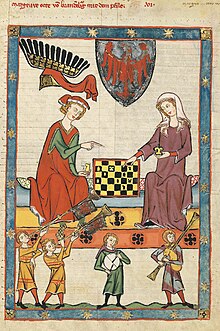Meaning perspective

The meaning perspective is a semantically guided representation principle of the painting of antiquity and the Middle Ages .
In the sculptures of ancient Egypt , higher-ranking people and gods are shown larger than subordinates.
The central perspective , which was already used to some extent in ancient times , was forgotten again in the Middle Ages and gave way to the perspective of meaning. Spatial thinking was lost and only returned with the Renaissance. Instead, in Gothic painting, figures and pictorial personnel were depicted according to their importance in the picture. For example, saints were shown in large size in the middle of a picture, while the donors of the work could be shown in a smaller size next to it, without taking spatial references or proportions into account (so-called donor pictures ).
Since other media of the visual arts have relieved the claim of naturalistic or even documentary reproduction obligations, examples of the use of perspectives of meaning can again be found in the figurative representations of classical modernism as well as in contemporary art.
Images in perspective of meaning can also be found in naive art and children's drawings .
In cartography, a map is called anamorphic map with an emphasis on certain content-related features .
literature
- Rebekka Drobe: Perspective of Meaning in Photography . Student thesis ("Large receipt"), TU Dresden 2005 ( full text ; PDF; 4.0 MB)